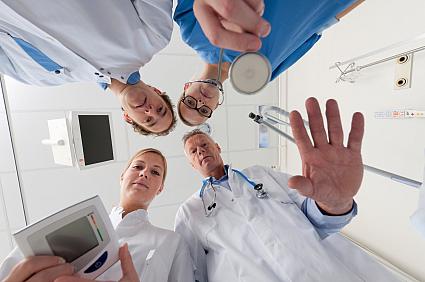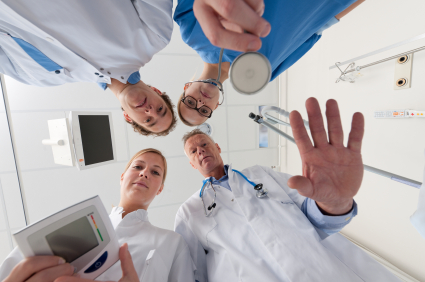Talk to Us! Health Journalism from a Patient's Perspective

 As a patient who was asked to speak at the Association of Health Care Journalists 2012 conference, I felt a bit covert. I wasn't in a "backless gown," rolling my IV pole down the hall of some hospital's cardiac care unit. I wore an official lanyard and badge and mixed among health care journalists, yet I felt more like a dugout mom than savvy reporter.
As a patient who was asked to speak at the Association of Health Care Journalists 2012 conference, I felt a bit covert. I wasn't in a "backless gown," rolling my IV pole down the hall of some hospital's cardiac care unit. I wore an official lanyard and badge and mixed among health care journalists, yet I felt more like a dugout mom than savvy reporter.
My goal was to present the patient's view. And I tried, in each session, to "be the ball" and hear what was presented from the alternate perspective, my persistent viewpoint as a user and purchaser of medical services. What I found is that health care journalists often have tendencies similar to those of health care providers.
It's complicated. You can't walk in the patient's shoes unless you have the misfortune of battling illness or disease. So it is with physicians as well. They have to speak authoritatively about issues they have never experienced but know from study and observation.
Yet the patient can easily imagine what it would be like to change places with the doctor. We each have areas of expertise. We each have been in the role of teaching, advising, problem solving – that is part of being human. But how can a doctor train to be sick, overcome the barbarity of surgery, struggle, persevere, and survive? There is only one way for that to happen (and it doesn't involve Artificial Intelligence).
Here is one example of the great doctor-patient divide: nothing is more defeating to a patient than hearing how physically healthy we appear. An online friend who endures coronary artery spasm, has had six heart attacks (yes, 6), breast cancer, double mastectomy, and two additional cancer surgeries was told in her pre-op Friday, "Well, you sure look good."
The fundamental problem in this anecdote and ones like it is that the health care provider can never, ever relate to what the patient has gone through. Instead of using a little humility and common sense, the fallback position is to "put a positive spin on it." Perhaps this disengaged approach is a means of self-preservation. Medical providers do it all the time. And what about health care journalists? I think you do. Not intentionally or maliciously, but I think in some way, you may add a bias to stories that says, "But, you look great."
At AHCJ, the session "Evaluating medical evidence for journalists" touched on this tendency. I was fascinated to learn that often when the stats I read seem too good to be true, they are in fact, too good to be true! An attempt to present apples-to-apples can be a cider variety-to-carambola comparison, if the absolute risks and benefits are not reported along with relative data. Through my filter as a patient, it sounded as though this trend happens more frequently as the rarity of a condition goes up, or perceived importance of it goes down. (Note: One patient's "rare" condition is another's misdiagnosed fatal heart attack.)
And that – mortality – is what makes the patient force a powerful one.
We empowered patients work for everyone – for ourselves, our doctors, our families, the future, even for the benefit of strangers. And, we work for free. If you as a journalist want to learn, we'll teach you. If you want contacts, we'll make the call. Want to see a medical device? Check out one of ours. Sternotomy scar? Step right up. Everything a patient has to share, be it knowledge or hardware, can make a difference for someone, somehow.
This drive is what makes patient support communities a rich source of story ideas and background material for journalists. Whether an in-person group or on-line community, patient relationships aren't superficial. The connections we have are deep and long-lasting. For this reason, we are protective of our crew and have high expectations.
One more story about my online friend illustrates this solidarity. The week before her third breast cancer surgery, she noticed in her hometown paper that a young mom, a nurse, had survived spontaneous coronary artery dissection (SCAD) and was out of work, struggling with recovery and finances – not to mention, she was trying to care for a newborn and six-year-old. The American Legion was hosting a spaghetti dinner benefit to help.
This Good Samaritan, who probably should have been concerned with her own pre-op affairs, which included traveling to Johns Hopkins, got online to rally the troops. She posted to all the Indianapolis ladies on the WomenHeart Online Support Community on Inspire. A few replied but we knew there were more. I shared the news with our SCAD Support Facebook group. Those women jumped back over to Inspire. There were offers of money, baby goods, food to bring in, even physical support. In a matter of hours, all this was accomplished and plans made by several locals to attend the spaghetti dinner and lift up this young mom. The online messages of support were printed and included in a "goodie bag" of WomenHeart health information and small gifts. The day after the benefit, there she was online – a new member of our community, thankful for the support and benefitting from the wisdom of the group.
Wisdom is not easy to come by, especially for those with complex medical issues. And, for this reason, Twitter can be a health journalist's virtual encyclopedia. Imagine sitting in the tip-off circle, center court at the Carrier Dome. The stands are completely filled with patients, physicians, specialists, researchers, and caregivers knowledgeable in every health condition you ever wanted to learn about. There they are, firing off a never ending stream of material for you. Granted, they are "tweeting" simultaneously for the most part, but you have the ability to sift through, interact, or just file these nuggets of information. For even more concentrated data, "lurk" or participate in a tweetchat on a given topic. In this forum, you'll have patients and experts practically writing your stories for you.
Even Facebook generates content, to my surprise. On my SCAD page of articles and news, for example, there is a fascinating conversation going on right now among a group in the UK who accessed a particular article. One is a SCAD patient, the second a paramedic, and a third, an ambulance volunteer. The patient has been asked to speak to med students about her SCAD and heart attack. The paramedic and volunteer have discussed the article and believe they have no role in diagnosing SCAD because of the need for an angiogram to confirm. Two of us concur that their awareness will make a difference.
It seems likely that most all health conditions have a presence on Facebook at this point. Not every group or online community would welcome a journalist's interest, of course. But as more and more patients seek to partner with every stakeholder available to improve outcomes and advance research, it might just be a "golden hour" for journalists and social media.
As a survivor of heart attack caused by spontaneous coronary artery dissection (SCAD), Katherine Leon generated research of SCAD at Mayo Clinic using social media. She spoke at AHCJ 2012 on the panel "How Will Citizen Scientists Impact Medicine."

